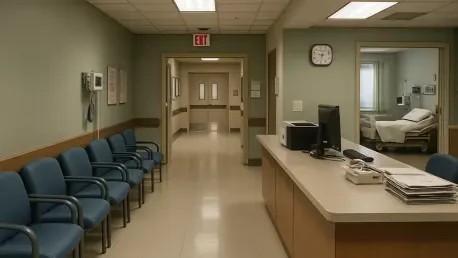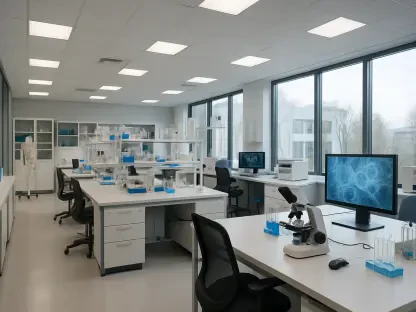In a dramatic and unprecedented development, the Trump administration has initiated a sweeping reduction-in-force (RIF) at the Department of Health and Human Services (HHS), terminating over 1,000 employees amid a government shutdown that entered its second week on October 14. This bold move, impacting between 1,100 and 1,200 workers initially, diverges sharply from standard shutdown practices where temporary furloughs are typical rather than permanent layoffs. Although approximately 700 employees at the Centers for Disease Control and Prevention (CDC) were reinstated due to an administrative error, the remaining cuts have ignited fierce criticism and raised serious concerns about the administration’s underlying intentions. The timing of these layoffs, set against the backdrop of a funding deadlock in Congress, amplifies the uncertainty surrounding federal healthcare operations. This situation not only challenges the stability of essential services but also sets the stage for a deeper examination of policy motives, political tensions, and the broader implications for public health in the United States.
Aggressive Push for Federal Downsizing
The Trump administration has positioned these layoffs as a cornerstone of its broader mission to streamline federal operations and advance the “Make America Healthy Again” agenda. HHS spokesperson Andrew Nixon clarified that the terminations specifically target “non-essential” personnel and aim to dismantle what the administration deems “wasteful and duplicative entities” within the department. This approach reflects a consistent pattern of workforce reduction efforts seen throughout the year, with HHS already experiencing significant staff cuts earlier and grappling with 32,000 furloughed employees due to the current funding lapse. The emphasis on trimming bureaucracy suggests a strategic reshaping of the department to align with ideological priorities, prioritizing efficiency over expansive government presence in healthcare.
Critics, however, question whether such aggressive cuts are feasible or even necessary under the current circumstances. The notion of “non-essential” workers being expendable during a shutdown overlooks the interconnected roles within HHS that support critical health programs. Beyond the immediate layoffs, the cumulative effect of prior RIFs and ongoing furloughs paints a picture of a department under severe strain, potentially compromising its readiness for unforeseen challenges. The administration’s unwavering commitment to downsizing, while framed as a fiscal necessity, risks creating long-term gaps in expertise and operational capacity. This policy push, though rooted in a clear vision, continues to stir debate over whether the costs of such drastic measures outweigh the purported benefits of a leaner government structure.
Political Tensions and Legal Challenges
The decision to execute these layoffs has unleashed a storm of political contention, with the Trump administration pointing fingers at Congressional Democrats for the shutdown and accusing them of perpetuating a “bloated bureaucracy” from previous leadership. This narrative seeks to justify the RIF as a necessary corrective action against years of perceived mismanagement. The administration’s rhetoric frames the funding stalemate as a Democratic failure, positioning the layoffs as an unavoidable consequence of legislative gridlock. Such statements have only deepened the divide, turning a workforce issue into a broader ideological battle over the size and role of government in public health services.
On the opposing side, Democrats, including prominent voices like Senator Patty Murray (D-Wash.), have condemned the firings as a reckless overreach of executive authority. They argue that a government shutdown does not provide legal grounds for permanent terminations, especially when essential services hang in the balance. Adding to the fray, unions such as the American Federation of Government Employees have launched legal challenges, asserting that preemptive threats of RIFs violate federal employment protections. These lawsuits highlight the chaotic nature of the layoffs and question the administration’s adherence to procedural norms. The clash of perspectives underscores a fundamental disagreement on governance, leaving the affected workers caught in a contentious crossfire with no immediate resolution in sight.
Impact on Public Health Operations
The operational fallout from the HHS layoffs poses a significant threat to the nation’s public health infrastructure at a particularly vulnerable moment. With the department already weakened by earlier staff reductions and widespread furloughs, the additional loss of around 600 employees across various divisions could impair its ability to respond to emergencies. Agencies like the CDC, despite the reinstatement of 700 workers, remain under pressure to maintain core functions such as disease surveillance and outbreak response. The ripple effects of these cuts could undermine confidence in the government’s capacity to safeguard public health, especially during a period of heightened uncertainty driven by the shutdown.
Moreover, the timing of these reductions amplifies existing challenges within HHS, where resources are stretched thin. The loss of personnel, even if categorized as “non-essential,” often disrupts the support systems that enable frontline health initiatives. As the department struggles to balance reduced staffing with ongoing demands, there is a tangible risk of delayed responses to critical issues, from vaccine distribution to health policy implementation. Stakeholders worry that the cumulative impact of these workforce decisions could have lasting consequences, potentially leaving the nation less prepared for future crises. The focus on immediate cost-cutting may inadvertently jeopardize long-term health security, raising urgent questions about prioritization in federal health management.
Scrutiny Over Timing and Implementation
The choice to implement permanent layoffs during a government shutdown, sparked by Congressional disputes over Affordable Care Act subsidies, has drawn intense scrutiny for its unconventional approach. Unlike typical shutdown scenarios where furloughs allow for eventual staff returns, these RIFs signal a more irreversible intent, prompting accusations of opportunism and poor planning. The administration’s decision to push forward with cuts at such a juncture appears to capitalize on the funding crisis as a pretext for broader workforce reduction goals. Critics argue that this move lacks the transparency and deliberation expected of significant policy shifts, casting doubt on its legitimacy.
Further complicating the narrative is the evident mishandling in the execution of these layoffs, as seen in the reinstatement of a substantial number of CDC employees due to a systemic error. This glitch reveals internal disorganization and fuels concerns about the haste with which the RIF was rolled out. While the administration remains resolute in maintaining cuts for the remaining affected workers, the incident underscores potential flaws in oversight and accountability. The combination of questionable timing and procedural missteps has intensified public and political discourse, with many calling for a reevaluation of how such drastic measures are initiated. This controversy continues to highlight the delicate balance between policy ambition and practical governance in times of crisis.
Reflecting on a Divisive Chapter
Looking back, the Trump administration’s decision to terminate HHS staff during a government shutdown marked a contentious moment in federal policy history. The initial impact on over 1,000 employees, mitigated partially by reinstatements at the CDC, reflected a determined effort to reshape the department under a banner of efficiency. Yet, the backlash from political opponents and unions, coupled with operational risks to public health, painted a complex picture of discord. Moving forward, addressing these challenges requires a renewed focus on transparent dialogue between stakeholders to prevent further erosion of essential services. Establishing clearer guidelines for workforce reductions during shutdowns could mitigate future conflicts, while prioritizing the stability of agencies like HHS remains paramount to ensure national health resilience.









